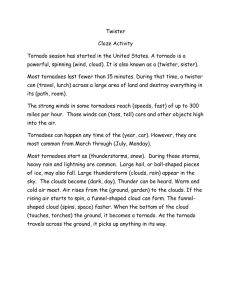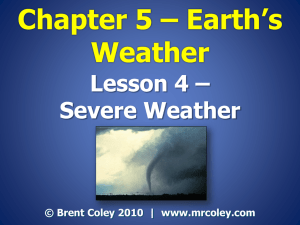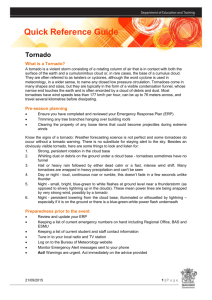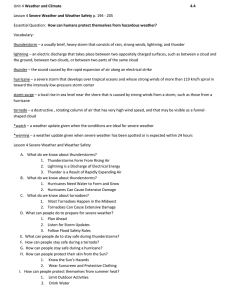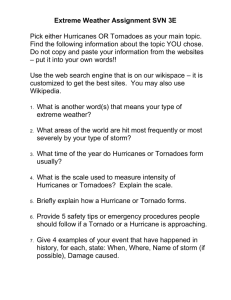Tornadoes
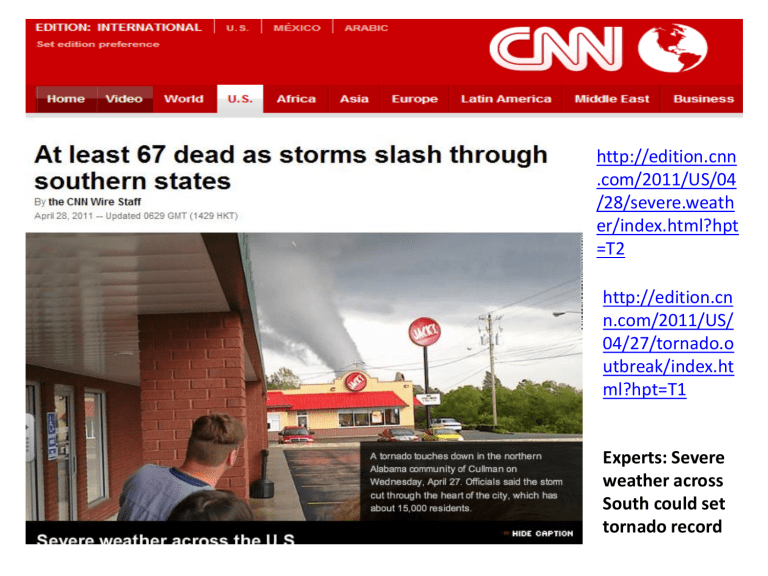
http://edition.cnn
.com/2011/US/04
/28/severe.weath
er/index.html?hpt
=T2 http://edition.cn
n.com/2011/US/
04/27/tornado.o
utbreak/index.ht
ml?hpt=T1
Experts: Severe weather across
South could set tornado record
Including yesterday's storm, there have been a whopping 800 reports of tornadoes in April , easily surpassing April 2003's all-time record of 543 twisters.
http://www.nytimes.com/interactive/20
11/04/28/us/map-of-the-tornadoesacross-the-south.html
The story of a tornado. The majority of tornadoes develop from severe thunderstorms. A hurricane, when it makes landfall, can also generate tornadoes.
The most damaging tornadoes form in large, powerful thunderstorms called supercells. For a supercell to form, and perhaps spawn a tornado, several conditions must exist.
1. There must be an adequate supply of moisture to feed the storm . In Tornado Alley, air from the Gulf of Mexico provides the moisture.
2. There must be a layer of warm, moist air near the ground and a layer of much cooler air above. Often, a front (the boundary between two air masses at different temperatures) powers an upward flow of warm air. As the warm air rises, it begins to cool, and the moisture it holds condenses into raindrops. The air stops rising at high levels and spreads sideways to form a characteristic anvil-shaped storm cloud .
3. For a supercell to develop , the winds at higher elevations must differ markedly from those at lower levels in speed, direction, or both . Such a large difference in wind speed or direction is called wind shear. Wind shear makes the column of rising air begin to rotate, forming a broad, horizontal tube of swirling air.
4. As the storm continues, this tube turns on its end, producing a rotating column of air called a mesocyclone. Studies show that most supercells containing mesocyclones eventually produce tornadoes. A low, dark, heavy cloud called a wall cloud forms underneath the mesocyclone. Tornado funnels develop out of the wall cloud.
The first sign of an approaching tornado may be light rain, followed by heavier rain, then rain mixed with hail .
The hailstones may grow to the size of golf balls or even baseballs. After the hail ends, a tornado may strike. I
In most tornadoes, a funnel-shaped cloud forms and descends from the wall cloud until it touches the ground . However, there might be a tornado even if the funnel does not touch the ground or if the air is too dry for a funnel cloud to form.
Sometimes, the first sign of a tornado is dust swirling just above the ground .
A few small tornadoes begin near the ground and build upward with no apparent connection to the storm aloft. Many of these storms occur without mesocyclones and lack a funnel cloud.
http://news.yahoo.com/s/yblog_thelookout/20110428/ts_yblog_thelookout/watc h-tuscaloosas-terrifying-tornado Yahoo video clips
Tornadoes Song: http://www.youtube.com/watch?v=iO w6ONcKk4g
A tornado is a rapidly whirling, funnel-shaped
cloud that reaches down from a storm cloud to touch Earth’s surface.
Tornadoes develop in low,heavy cumulonimbus clouds—the same clouds that bring thunderstorms.
http://news.yahoo.com/s/yblog_thelookout/2
0110428/ts_yblog_thelookout/watchtuscaloosas-terrifying-tornado
Yahoo video clips
Torn
adoes
http://news.yahoo.com/s/yblog_thelookout/2
0110428/ts_yblog_thelookout/watchtuscaloosas-terrifying-tornado
Yahoo video clips
Torn
adoes
The jet stream is the main reason for all the severe weather. The warm humid air from the south is clashing with the cool dry air coming down from Canada and where the two meet is where we find severe thunderstorms and tornadoes.
Including yesterday's storm, there have been a whopping 800 reports of tornadoes in April , easily surpassing April 2003's all-time record of 543 twisters.
http://www.nytimes.com/interactive/20
11/04/28/us/map-of-the-tornadoesacross-the-south.html
